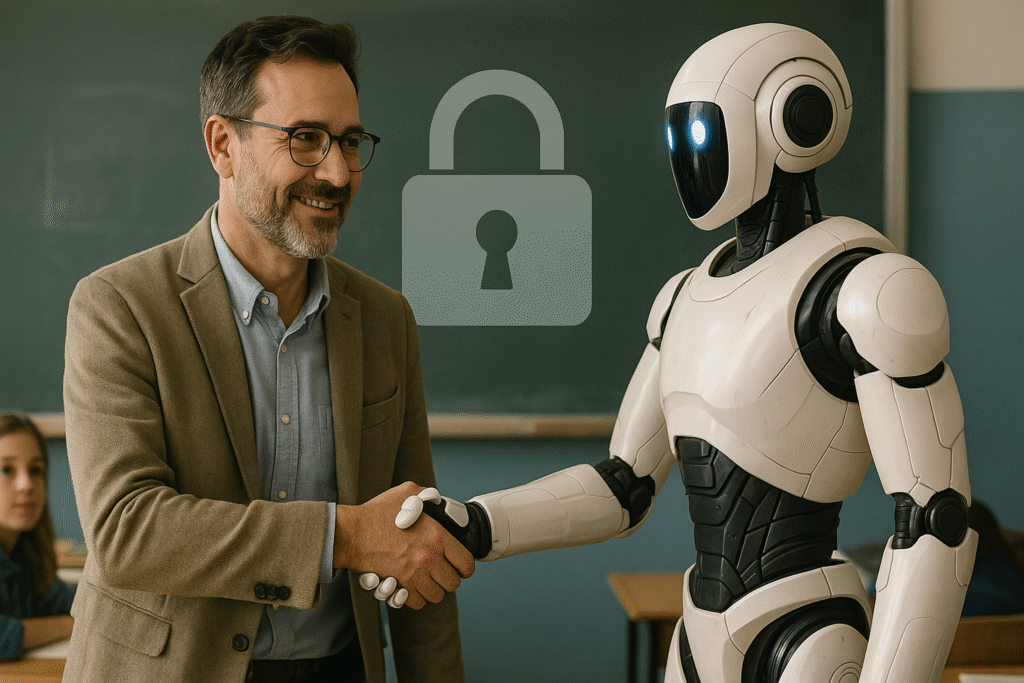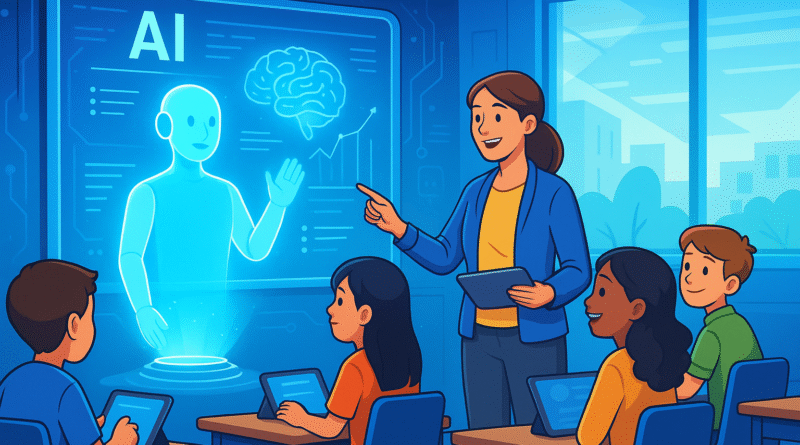AI in Education: Transforming the Classroom of the Future
AI in Education Introduction
If you walked into a classroom in 2025, don’t be surprised if the teacher is getting help from a digital assistant, students are getting personalized learning paths in real-time, and homework is graded before they even leave the room. No, it’s not Hogwarts. It’s AI in education, and the chalkboard days are officially behind us.
From kindergarten to corporate training rooms, Artificial Intelligence is quietly changing the way we learn, teach, and think about education itself. It’s not replacing teachers (we still need the humans, thankfully), but it’s reshaping the classroom into a more efficient, inclusive, and even enjoyable place.
Let’s explore how AI is transforming education, and why students today might be the luckiest learners in history.
Table of Contents
Why This Matters Now
The world is changing fast, and traditional education models are struggling to keep up. One-size-fits-all curricula, overloaded teachers, and outdated testing methods are making learning less effective, and sometimes even boring.
Here’s the challenge:
- Classrooms are more diverse than ever, culturally, socially, and cognitively.
- Teachers are stretched thin trying to meet individual needs.
- Digital natives expect more interactivity and tech in their learning experience.
Enter AI: the tech-powered assistant that’s helping education become more adaptive, personalized, and scalable, without losing the human touch.
Just like it’s transforming mental health, AI is now revolutionizing classrooms too. Read how it supports therapy here.
1. Personalized Learning: Because Not Everyone Learns the Same Way
Let’s face it: not every student thrives in the same environment. Some are visual learners. Others need to hear it, write it, or do it five times before it clicks. AI makes personalized learning at scale finally possible.
How it works:
AI systems track how students learn, their speed, style, strengths, and struggles. Based on this data, it tailors:
- Lesson difficulty
- Pace of delivery
- Types of exercises
- Feedback and support
Example:
If a student is struggling with fractions but excelling in geometry, the system slows down the math module while accelerating spatial lessons. No judgment, just tailored help.
This turns learning into a journey that fits the student, not the other way around.
2. Smart Tutors: 24/7 Help Without Burnout
Remember that feeling when you got stuck on a math problem at 10PM and wished someone could help? Now, you can just ask your AI tutor.
Tools like:
- Socratic by Google (which uses NLP to explain homework step-by-step). Chat-based AI like ChatGPT is already making waves in tutoring and business. Here’s how it’s helping companies too.
- Khan Academy’s AI coach Khan Academy is also piloting AI-powered personal guides to support student progress.
- Quizlet’s AI-generated flashcards
These tools offer:
- Instant feedback
- Adaptive quizzes
- Explanations based on the student’s comprehension level
Unlike private tutors, AI doesn’t get tired, doesn’t cancel, and doesn’t judge. It’s like having a genius study buddy with infinite patience (a rare species indeed).
3. Automating the Boring Stuff: Let Teachers Focus on Teaching
Teachers didn’t sign up to spend half their time grading papers or updating lesson logs. AI is stepping in to handle:
- Grading (essays, quizzes, even presentations)
- Attendance tracking
- Homework reminders
- Learning analytics
This means teachers can focus on:
- Coaching
- Creativity
- Emotional support
- Real interaction
In other words, AI helps teachers do what machines can’t: connect with students as human beings.
4. Real-Time Language Translation: Breaking the Barrier
In today’s global classroom, language can be a hurdle. But AI-powered translation tools like Google Translate, DeepL, and even Zoom’s live captions are breaking down that wall.
Use cases:
- Multilingual classrooms where students learn in their native tongue
- Foreign exchange students accessing native-level support
- Teachers reaching international audiences through subtitles or real-time captioning
Learning is no longer limited by language. And that’s huge for inclusivity and global collaboration.
Powerful tools like DeepL enable near-native translations for students worldwide.
5. Early Warning Systems: Catching Problems Before They Grow
AI can analyze student behavior and performance to detect patterns that suggest:
- Learning disabilities
- Risk of dropping out
- Emotional distress
- Disengagement
Example:
A student’s grades drop, participation fades, and login frequency slows down. The AI flags it. The teacher gets a nudge:
“Check in with Sam. Engagement is down 35% in the last two weeks.”
This isn’t about surveillance, it’s about support.
AI helps educators intervene early, gently, and effectively, before small issues become big problems.
6. Immersive Learning with AI and AR/VR

source: virtualspeech.com
Education is no longer confined to the classroom. With AI + augmented/virtual reality, learning is:
- Visual
- Interactive
- Experiential
Imagine:
- Walking through a virtual ancient city with an AI guide explaining history
- Running a virtual science experiment safely in your bedroom
- Exploring outer space from a VR headset while AI quizzes your understanding
This isn’t just cool tech, it increases retention and makes abstract concepts feel real.
7. Lifelong Learning and Skill Building: AI Goes Beyond School
Learning doesn’t stop at graduation. AI is also reshaping:
- Online courses (Coursera, Udemy, edX use AI for recommendations)
- Corporate training platforms (like LinkedIn Learning)
- AI-driven upskilling (Tailored paths based on current job + career goals)
Example:
You want to transition into data science. AI scans your current skills, recommends courses, provides feedback, and adjusts pace based on your learning speed.
AI is democratizing lifelong education, making it smarter, faster, and flexible enough for your schedule.
8. Ethical Considerations: The Chalk Outline Around Privacy

With all this data flying around, the question is inevitable:
“Is AI watching me take notes… or my cat walk across the keyboard?”
Here’s what we need to be careful about:
- Data privacy: What’s collected, who owns it, and how it’s used
- Bias in AI: Algorithms must be trained on diverse data or risk perpetuating inequality
- Overreliance: Tech is a tool, not a replacement for real-world interaction
Solution?
Transparency, regulation, and most importantly, human oversight.
FAQ
Q1: Will AI replace teachers?
A1: Nope. AI enhances teaching by handling the repetitive stuff and providing personalized insights. But human connection, mentorship, and creativity? That’s still Team Human’s job.
Q2: Is AI in classrooms affordable?
A2: Many AI tools are becoming more accessible and scalable. Governments and edtech companies are working on making these technologies available even in underserved areas.
Q3: What about data privacy for students?
A3: The best AI platforms are designed to comply with laws like GDPR and COPPA. Still, schools and developers must prioritize transparency and ethical data use.
Final Thoughts
The classroom of the future isn’t run by robots. It’s guided by teachers, supported by AI, and powered by the idea that every student deserves a personalized, engaging, and equitable learning experience.
With tools that adapt to each learner, free teachers to do their best work, and open up new ways to experience knowledge, AI is quietly (and sometimes not-so-quietly) changing everything.
So whether you’re a teacher, a parent, a student, or just someone who’s curious about how kids are learning these days, remember this:
AI isn’t replacing education. It’s finally helping it reach its potential.
Want to explore more about how AI is shaping the future? Keep following us at aihunterguides.com, where we simplify smart tech and bring it down to earth.

Pingback: Exploring AI in Personalized Learning Experiences
Pingback: The Environmental Impact of AI: Can It Be Sustainable?